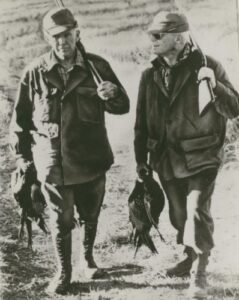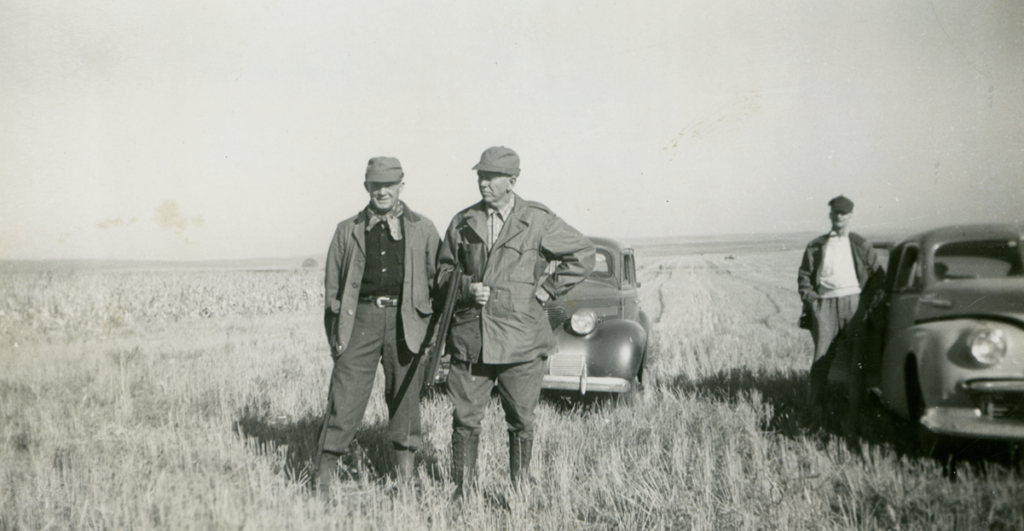 In October, we received a question from Steven Kinsella about a photo of Generals George Marshall and Henry “Hap” Arnold pheasant hunting. He asked if GCMF staff knew who took it, and raised an intriguing possibility:
In October, we received a question from Steven Kinsella about a photo of Generals George Marshall and Henry “Hap” Arnold pheasant hunting. He asked if GCMF staff knew who took it, and raised an intriguing possibility:
“I think it may have been my grandfather Rolf Normann or the commander of the Bismarck, ND airbase. My grandfather, who lived in Bismarck and was an active and accomplished pheasant hunter, was their guide that day. I have another original photo of Generals Marshall and Arnold that day in the field with their pheasants. I also have one of the two of them and my grandfather and the commander of the Bismarck base posing together. If you want to see these images, I’d be happy to send you copies.”
The Marshall Foundation thanks Mr. Kinsella for sharing these wonderful photos and the valuable context that bring his family’s history to life in such a meaningful way!
Steven Kinsella
When my grandfather, Rolf Normann, a graduate of the University of Minnesota’s School of Engineering, moved to Bismarck, North Dakota in the 1920s it was a seismic change for him. Minnesota, known as the Land of 10,000 Lakes, has far more surface water and nearly double the annual precipitation of central North Dakota, which sits on the semi-arid Great Plains. To make matters more challenging, shortly after he and my grandmother moved there to help start a new company that built and sold bridge beams, concrete storm drains and sewer systems, the Depression and the Dust Bowl would begin. He was tasked with convincing potential customers that they needed to buy bridges over creeks that had long run dry and stormwater systems where runoff had long ceased to happen.
But what the parched North Dakota prairie lacked in terms of water and rainfall, it more than made up for in pheasants, grouse and prairie chickens, and my grandfather was an avid and accomplished upland bird hunter. He would often bring home a trunk full of pheasants for my grandmother to cook for dinner or can in her stovetop pressure cooker for use in dinner parties and Sunday dinners. During Prohibition, he and my grandmother would often venture up to the Canadian border and hunt pheasants and grouse there, slipping across the border to replenish the household supply of liquor, which my grandmother would stuff into the front of her overalls so if stopped she would appear pregnant rather than as a “rum runner.”
One of the greatest thrills of his life was the day in late 1945 when a mutual friend of friends of my grandparents—the commander of the 7th Ferry Command of the U.S Army Air Corps Bismarck Air Base—asked if my grandfather would be willing to take a couple of visiting military dignitaries pheasant hunting. Those dignitaries were Generals George Marshall and Hap Arnold, who were also avid hunters.
My aunt, Sylvia Helsper of Bellevue, Washington, remembers the day well. Eleven years old at the time, she said that my grandfather thought it was a great honor to be able to be the generals’ guide for the day. She said that, “as a stoic Norwegian, he was never excited by much but he was very excited that day.” That excitement made sense because not only would he spend the day doing something he loved, but he was also going to do it with two of the most well-known Americans of the time who had helped engineer the nation’s success in World War II.
“At the end of the day he reported that the generals weren’t very chatty but were nice fellows who were very intent on hunting,” said my aunt, who made her own contribution to the war effort by going door-to-door in Bismarck collecting paper and glass for the war effort, receiving a certificate of merit as a “paper trooper.”
Also an avid amateur photographer, my grandfather took photos that day of the generals with their shotguns and the pheasants they harvested. He loaned his camera to one of the hunt’s attendees so that he could have his photograph taken with the generals and the commander of the Bismarck Air Base, a photo that my family cherishes.
Like my aunt, my mother Audrey also played a role in the war effort. Within days of graduating from high school, she took the train to Washington, D.C., and went to work for the Navy Department as a typist in one of the temporary buildings the U.S. government built on National Mall to meet the need for office space during the war. One morning, she walked into her office building to find two canned pheasants sitting on her desk. There was no letter or note to indicate where they had come from. It was only after she moved back to Bismarck that she learned that the generals had agreed to ferry back with them a couple of my grandmother’s canned pheasants as a surprise gift to my mother from back home.

